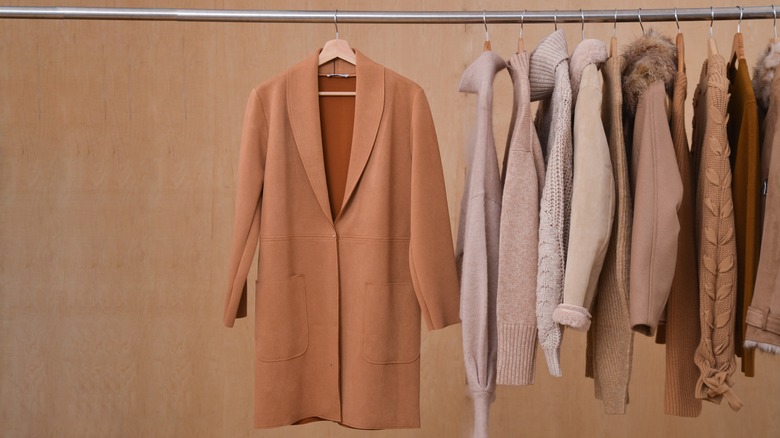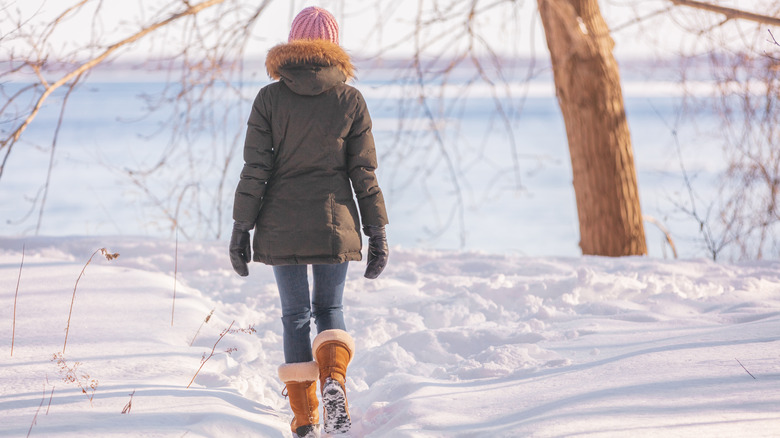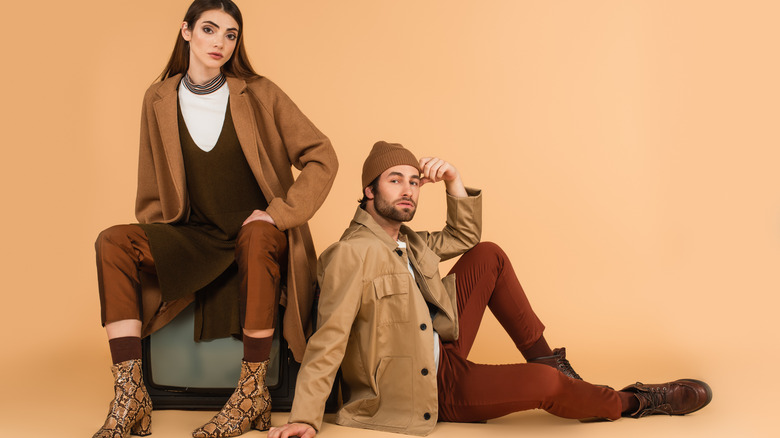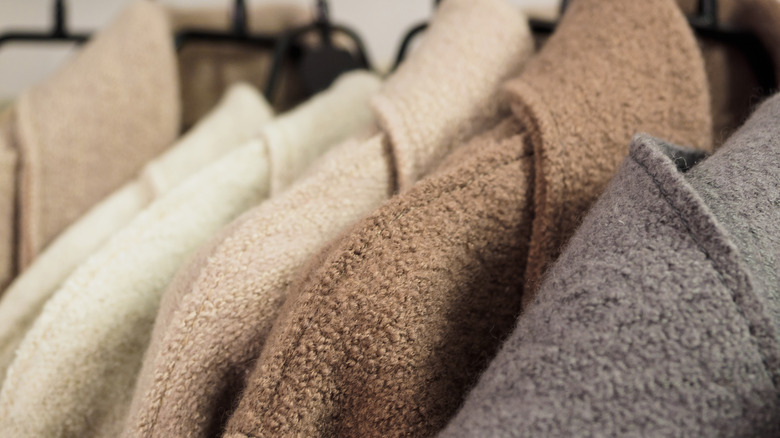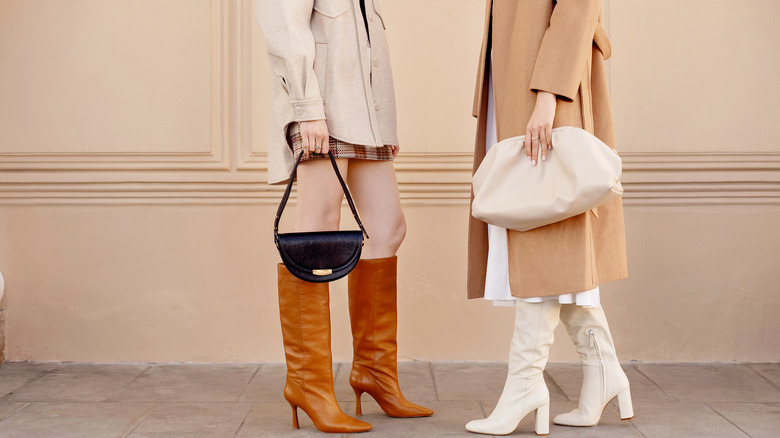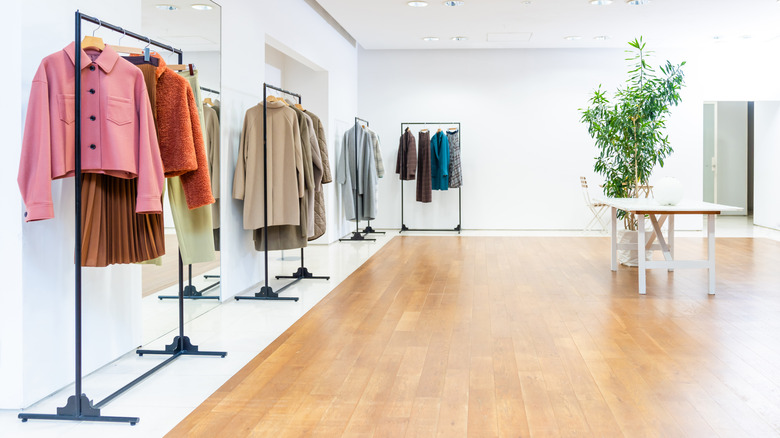What To Consider Before You Buy Your Next Winter Coat
If you live in an area with cold weather or frequent precipitation, you'd be wise to invest in a quality winter coat. However, since these pieces of outerwear can be very expensive, it's important to compare and contrast all of your options before purchasing. First, let's make the difference between a coat and a jacket very clear. According to Pediaa, coats are either waist-length or longer and are usually made out of heavier materials than jackets, making them better suited for winter weather. Further, coats can sometimes appear more formal than jackets. Some of the most popular types include trench coats, parkas, and wrap or belted styles, per The Trend Spotter.
There are five things to consider before buying a winter coat: how it will be most used, which style and fit you prefer, what color you desire, which material will provide you with the most benefits, and how much you're willing to spend. You'll find an in-depth summary of each of these considerations below.
Consider the use
The first thing you need to consider is where you'll be wearing the coat and for what purpose, as this will help you narrow down your choices in the other categories. Possible uses include wearing in wet, windy, or snowy weather conditions. Or, maybe you need it for formal settings like work events. On the other hand, perhaps you're looking for something more casual to wear every day. If your main concern is fashion, think about whether or not you'll be wearing it frequently or just as a statement piece. Perhaps you want a coat that fits into multiple categories, in which case you're looking for something versatile.
Chatelaine says that those who desire a functional coat should look for these three characteristics: First, a removable hood, so the article of clothing is easier to clean and versatile, second, a dual zipper, which will make it easier to sit down comfortably, and third, deep pockets to carry things like your keys and wallet. However, if you're more worried about fashion, these considerations may not be as important to you. Those who are most concerned about the appearance of their coat may want to focus on choosing something that will fit into the rest of their wardrobe since this outer layer is the main thing everyone will see you wear during the winter, per Town&Country.
Think about the style and fit
Once you've decided where you'll be wearing it, you can then think about the style and fit. Beginning with the fit, Town&Country recommends sizing up so that your winter clothes can fit comfortably underneath. Sleeves should reach the beginning of your thumb, belts should be at your waistline, and shoulders shouldn't feel too large or too snug. What's most important is that the outerwear feels comfortable, especially if you plan to wear it every day.
The Trend Spotter names some of the most popular coat options. Those looking for something lightweight and waterproof should check out trench coats, which fall close to the knee, and raincoats, which are sometimes shorter and come in lots of fun colors. If you're worried about cold weather, a parka or duffle, which both usually fall to the thighs, or a peacoat, which falls to the hip, could suit you well. Those looking for something to wear in formal settings should check out a long chesterfield style or a well-fitted military look, while shorter cape and cocoon styles could work in casual settings. Finally, those looking for an extra versatile type may benefit from a wrap or belted coat, while those wanting the longest look possible should try a maxi.
Determine the color
Next, you'll need to choose the color, which will be largely impacted by both the use and the style. For instance, if you're choosing a coat for formal events in a chesterfield style, going with a neutral tone would be best. On the other hand, those looking for a casual coat or one that's only worn as a statement piece may want to choose a bolder color.
According to Economy of Style, some of the most popular coat colors are navy, red, and green, but if you're going for a neutral tone, choose black, camel, gray, or off-white. When deciding which tone is right for you, think about the clothes in your closet — what will match the articles of clothing you already have? Further, if you're investing in your piece, make sure you don't choose a color that will quickly go out of style. Also, think about whether or not you're comfortable choosing a shade that may make you stand out in a crowd, as this could cause you to get less wear out of your expensive piece. Lands' End encourages those who want a fun color to choose one that matches their physical features. For instance, those with darker hair and complexion would look great in a bolder color, while those with fair skin and hair may want to choose a pastel or lighter tone.
Weigh the pros and cons of materials
Coats can also be made out of many different types of materials; While some are heavier and made for colder weather, others are more lightweight and breathable. The material you choose will largely be determined by the weather where you live and the use of your coat, as well as the style. When discussing materials, it's important to understand the three main parts of a jacket, as outlined by Burlington. The shell is the outer layer, the lining is what's closest to your body, and the filling is what's stuffed inside the coat to add warmth. Therefore, while the outside of your coat may be made out of one material, the lining may be made out of something else, and both these materials are important to consider.
According to Thread Curve, materials like cotton, polyester, and fleece are usually used as linings, as they are comfortable and can add a layer of warmth. More durable, warm, and water-resistant materials such as canvas and wool are used on the outer layer of coats. For something durable but also lightweight, look to nylon. If you're desiring a high-end look, choose a fur, faux fur, or gabardine coat. Those desiring a casual look could choose either textured corduroy, rough tweed, or furry chenille.
Narrow down options with your budget
Finally, once you've chosen the use, style and fit, color, and material, it's time to narrow down your search by considering how much you're willing to spend. On average, people spend about $100 to $300 on a coat, but they can be priced for as high as thousands of dollars, per Newsy. If you're choosing a timeless look such as a peacoat, you may want to spend more, as it will last for a long time and may be worth the investment. On the other hand, Chatelaine says that those looking to try out a trendy appearance may want to spend less, as you probably won't get as much use out of the piece.
There are also a number of ways to save money while winter coat shopping. For instance, as the temperatures start warming up in the spring, outerwear should start to be put on sale, so this may be the best time to buy. Further, choosing a coat that has convertible elements, such as one with a detachable hood, vest, or inner lining, may save you money, as you'll get more use out of it without having to buy multiple pieces.
